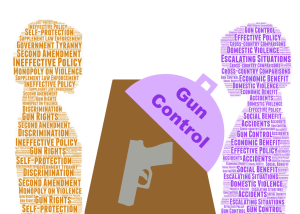Pro (more gun control)
April 21, 2021
Virginia Tech. Sandy Hook. Marjory Stoneman Douglas. Schools made infamous as the sites of tragic school shootings. Spurred by these incidents, questions linger in the minds of teachers, parents and students alike: Could something have been done to prevent this? Can something still be done to prevent it in the future?
The answer lies in gun control, stricter regulation of the sale and use of firearms. The argument for gun control is simple: by imposing more restrictions on who can buy guns and when they can be used, gun deaths can be significantly reduced.
“I think firearms should be treated like cars,” said Government and Politics teacher David Pugh. “You have to pass a test; you have to show that you are competent and proficient, as opposed to just walking in and buying a gun. You don’t just walk in and buy a car without a driver’s license, so I strongly believe in a background check.”
A study analyzing the effects of state laws regulating firearm access and use found that combining three classes of gun control laws — regulating children’s access to firearms, carrying a concealed firearm and using a firearm in self defense — would result in 4,475 fewer deaths in a hypothetical situation of 39,000 firearm deaths nationally.
Although reducing deaths is the overwhelming benefit of gun control laws, reducing gun deaths can also yield an economic benefit. A report published by the U.S. Congress Joint Economic Committee in 2019 revealed that in 2017, gun violence cost the national economy $229 billion due to direct measurable costs such as lost income and spending, police and criminal justice responses and health care treatment. California’s cost of gun violence was the highest in the nation — $18 billion. Gun control measures would effectively alleviate the social, emotional and economic stress that gun violence places on communities.
Apart from studies, countries with more restrictive gun laws also demonstrate the efficacy of such regulations. According to CNN, Americans own 46% of all civilian-owned guns worldwide, gun homicide rates in America are 25.2 times higher than other high-income countries. Simply put, these differences can be attributed to stricter gun control.
“Just compare statistics between the US and other democracies with a similar culture, like Canada, Australia, New Zealand and the United Kingdom,” Pugh said. “It’s not even close. Their numbers of gun deaths and shootings are a fraction of what they are here.”
A notable example of swift, effective government action is the Port Arthur massacre in Australia, which almost immediately led to gun control legislation being passed and a large-scale operation to buy back firearms from citizens. Around 643,000 firearms were handed in, demonstrating the efficacy of such measures.
Opponents of gun control, however, argue that such regulations are an infringement of Second Amendment rights. Although the Second Amendment does protect the “right of the people to keep and bear Arms,” it is written in the context of “a well regulated Militia,” which does not apply to ordinary citizens. Thus, the Second Amendment protects the rights of militias, not individuals, and cannot be interpreted as an unlimited right to own guns.
In addition, considering the historical context in which the Second Amendment was written and current technological advances, it is clear that the right to own guns in the modern day must be considered more carefully than ever.
Another common argument against increased gun control is that the right to own firearms is crucial for civilians to protect themselves. However, guns are rarely used in self defense. A 2013 study found that during the time period from 2007 to 2011, the threat or use of firearms was the least common self-protective behavior for both violent crimes and property crimes — approximately 0.8% for violent crimes and 0.1% for property crimes.
“One of the arguments is that you need a gun to protect yourself and your family,” Pugh said. “That argument is absolutely legitimate. The legal term is the Castle Doctrine, which is often referred to as ‘stand your ground’ if you are facing imminent danger of physical harm. But statistically, the number of times firearms are used for protection is considerably less than shootings involving accidents, domestic violence and suicides. It’s a trade-off.”
The use of a gun in self defense is also likely to escalate the situation into violent or potentially fatal altercation. The Harvard Injury Control Research Center found that guns are used to intimidate others far more often than they are used for justifiable self-defense. In addition, legally owned guns are frequently stolen and used by criminals, contributing to the issue of unlawful possession of firearms. The Bureau of Justice Statistics reported 1.4 million firearms stolen during property crimes from 2005 through 2010. Although citizens purchase firearms for self defense, the fact that firearms are rarely used in self defense and the likelihood of theft ultimately lead to less safety.
The use of firearms comes with great responsibility, and the government has a duty to keep its citizens safe with comprehensive gun control laws that will hold firearm owners accountable.


































































